Case Study: Seymours
Wensleydale Station: The epitome of “trees for all reasons”
Overview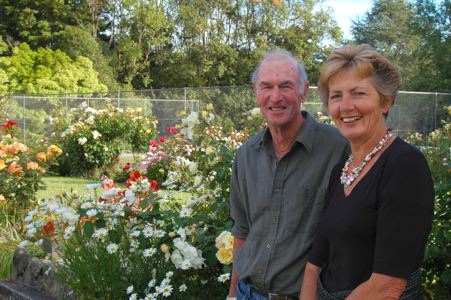
Nick and Pat Seymour’s Wensleydale Station lies in the Waiomoko catchment at Whangara, around 30 km north of Gisborne. The farms here were taken up in 1901 out of the government survey block, and the property was originally purchased by Nick’s grandfather in 1912 as a breeding farm, supplying sale stock for finishing to the home farm of Mangaone just 6-7 km away. After he died in 1926 the farm was run by managers for the next four decades, and with little investment going back into the land Nick faced major challenges when he was given the opportunity to run this part of the family estate in 1962.
Nick and Pat married in 1966, and because so little money had been spent on the property they faced an immediate challenge to try and turn it around. Wensleydale at that time had big paddocks and low stocking rates, so he increased the sheep numbers and managed to break the country in quite quickly by mob stocking using Perendales.
Lack of water was another priority issue, and a lot of dams have gone in over the years since.
In the 1970s they subdivided the big paddocks, and continued to improve farm access.
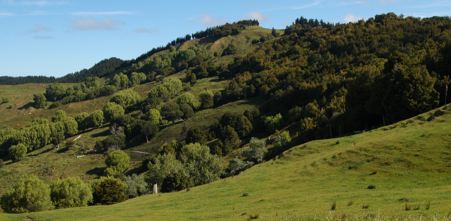 Initial tree plantings were to retain soil on the erosion-prone country, with thousands of poplar and willow pole plantings under a succession of Poverty Bay Catchment Board five year plans The first conservation plantings were made, followed by agroforestry plantings in the 80s and East Coast Forestry Project plantings in the '90s.
Initial tree plantings were to retain soil on the erosion-prone country, with thousands of poplar and willow pole plantings under a succession of Poverty Bay Catchment Board five year plans The first conservation plantings were made, followed by agroforestry plantings in the 80s and East Coast Forestry Project plantings in the '90s.
Today Wensleydale Station is an outstanding example of how trees can be used to heal erosion and stabilise vulnerable East Coast properties, while enhancing livestock management, and creating financial flexibility for the future - as well as a visually attractive environment in which to live and work. The Wensleydale landscape is the culmination of Pat and Nick’s vision for their land: to keep it sustainable and in good health, and to be good custodians, leaving it in better condition for the next generation. “Look after the land and the land will look after you” is their guiding principle.
Land description
Wensleydale Station covers an area of 811 ha of moderately steep (Class VI and VII) summer dry hill country.
Predominant LUCs for Wensleydale
| Class | Hectares | % of land area |
|---|---|---|
| III | 9.4 | 1 |
| IV | 2 | 0.3 |
| VI | 473.2 | 50 |
| VII | 326.7 | 41 |
The soil type is a loam and ash overlay on a clay and papa base. Total farmed area is 602 ha, with 170 ha of forestry plantings and QEII reserves totalling 30ha.
| Total farm area | Hectares |
|---|---|
| Farmed | 602 |
| QEII Trust reserves (3) | 30 |
| Agroforestry blocks | 30 |
| ECFP grant areas | 140 |
| House & yards etc | 8 |
Water is from natural creeks and dams, and tends to last last through everything but a major drought (such as the 82-83 drought). The property includes three strong springs that were tapped in the 80s, and although these now need to be tapped again because of earth movement, will reportedly run a half inch hose all day.
Farm operation
Nick recalls that in 1962 when he first came to Wensleydale there were very few paddocks, not many dams and the property carried about the same number of ewes and pretty similar stock numbers to those at time of writing - about 2200-2300 ewes, and about 120 cows, and steers up to 18mths – 2 years, which would go to Mangaone for finishing. The pastures were terrible, he says.
After trialling various composites over the years he settled on Border-Finn-Romney ewes lambing at around 135%.
“We had lots of rats tail – big stuff, it looked like rush bushes, so I increased the stock for a start and changed the sheep from Romneys to Perendales. I had a very good Perendale flock. We were relying on wool as well as the lambs and cattle, but the wool from Perendales dropped marginally. The sheep did a marvelous job cleaning up the country… they are a forager and don’t like soft food like grass, like Border Leicesters and the Border Coopworths that were coming… they were much hardier.
“However they did eat all my winter cattle feed out so we had a problem there, especially when I got the cows up to about 300. Again, that was to try and tidy up the back country. But we always had skinny cattle so we cut them down progressively at each drought we’ve had . We’ve had a number of droughts and cattle are hard to get through.
“In 1966 we had about 280 cows and progressively brought them back to around 240-260 and that was a pretty good mix. We went back out of the Perendales and went into Romneys. However with the Romneys, the lambing percentage dropped back to around 100% and we were lucky to get that sometimes because of the autumn storms.
“In the 90s I got onto some composite sheep that had a bit of Finn in them and East Friesian, a bit of Border and a bit of Polled Dorset ,and they dramatically increased the lambing percentage but we ran into foot problems with those, so since 2000 we’ve had Border-Finn-Romney ewes and they’ve been scanning consistently at 160% and lambing at around 135%.
The Seymours ran a maximum of 120 Friesian bulls and finished those at 600kg, killing out at 300kg.
Stock numbers as at July 2008: 9.1 su/ha, 5500 su wintered.
| Breeding ewes | 2200 |
| Breeding cows | 140 |
| 2 yr steers | 72 |
| 1 yr steers | 68 |
| Prime lambs | 1800 |
| 2 yr bulls | 64 |
| 1 yr bulls | 56 |
| 2 yr heifers | 50 |
| 1 yr heifers | 56 |
Despite taking 170ha out of production stock numbers have dropped only slightly, from 5800 in 1997 to 5500 su in 2008.
Nick pays special tribute to stock manager Turei White who came to Wensleydale in the 70s and worked there for 35 years. He says it was a bit of a luxury having two people on a property that size, but in the 80s when there was no money Turei did all the stock work while Nick did all the forestry and helped with the shearing. Things got easier once the property was fenced up.
In 2008, after 46 years of managing the livestock operation and getting the farm to a high standard, Nick and Pat felt it was time to bring in someone new. After careful thought they decided to lease the livestock operation, then running with 5500 su on 600 ha. Glenn Prebble (son of former NZFFA president John and Heather Prebble) was keen to progress from being a manager on a big farm to his own operation, and confident he could manage it on his own, so after some negotiation he took over on 1 July 2008. Glenn has changed the stocking ratio towards more cattle, a few more bulls, and fewer sheep. Nick and Pat continue to live on Wensleydale and Nick oversees the 200 ha of forestry and QEII reserves.
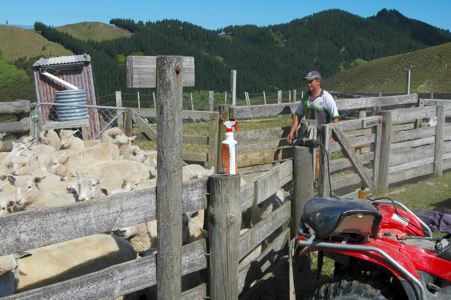
Climate
While the temperature occasionally gets down to 5 degrees C in the winter in daytime, that is regarded as pretty cold for Wensleydale. It rises to 26-30 degrees in the summer. Early Catchment Board records showed the mean average temperature as 14.5 degrees but Nick feels this has probably risen over the years.
He estimates rainfall at around 1143 mm (45 inches) annually, averaging more than 914 mm (36”) most years.
The prevailing wind is the nor-westerly which, as the dry quarter, is the worst. Rains come from the north east including cyclonic rain storms from the tropics. “And we’ve had our moments with them!” says Nick. Winds tend not to be an issue – the problems are more due to the combination of rainfall, soils and topography.
Vegetation
Nick says he has cleared scrub in Number 1 and 2 paddocks but then replanted in pines because it is low fertility soil that kanuka and mānuka thrive on.
The western faces are the dryer country and he feels this was probably burnt in pre-European times.
“The old kanuka we’ve got, I’m pretty sure it must have been cleared by the Maori. It’s very old - it’s 6-8m high but it’s just getting dry rot and collapsing, it’s so old.”
Before settlement all the eastern and southern country had big bush on it… podocarps, puriri, rewa rewa, tawa, pukatea, kohekohe, totara and matai are all represented in the covenanted remnant patches.
Environmental issues
As everyone that reads newspaper headlines knows, the Gisborne District has a severe erosion problem. Twenty-six percent of Gisborne district’s land is susceptible to severe erosion compared to only 8 percent of all land in New Zealand. Wensleydale is not immune and suffers from slumping and surface slips.
The East Coast Forestry Project was introduced by the government in 1992 to encourage planting of trees or reversion to native bush to help combat the erosion problem.
More recently the Gisborne District Council has established its Sustainable Hill Country Project. Under the Combined Regional Land and District Plan, land in Overlay 3A areas must be treated with “effective tree planting” or reserve fencing, with a farm plan in place by 2011.
Floods have hit repeatedly. In 1977 an extreme flood hit the Whangara area and the back of Gisborne. Seventeen inches of rain were recorded in 17 hours at Glenroy Station at the boundary with Wensleydale. That water all came down through the catchments of the Waiomoko River. The Seymours were building a bridge over to the woolshed at the time and had just taken the boxing off the abutments. The next day the bridge disappeared under the flood waters and the sheep yards were buried under a metre of silt. It took five years to put the flood gates back in and mend the fences.
At the other extreme Wensleydale experiences a drought approximately every eight years or so. However the 80s were particularly dry and there were three or four in a row – in stark contrast to the 70s, which were very wet.
The role of trees on Wensleydale Station
Nick credits his visits as a teenager to an uncle’s farm where trees were an important part of the working environment, then spending six months after graduation from Massey University collecting pine cones for seed production in the middle of Kaingaroa Forest, with stimulating his early interest in trees.
His planting at Wensleydale has gone through several distinct phases, starting with planting for control of soil erosion, followed by agroforestry, and finally looking to a future where forestry could provide a financial benefit for the next generation.
It is all about planning and getting the trees in the ground, he says, stressing that trees and livestock farming should complement each other, not compete. The concept of the farm forestry model is all about planting trees on lower fertility soils that do not have the capacity to carry more that 8 su per hectare. Often these soils are on steep land that will likely only grow poor quality grass or revert to mānuka, kanuka, tahine or gorse. These hillsides are frequently unstable.
Another option is allowing the reversion of native tree species by retiring the area from livestock or planting potted seedlings. Good fencing, grass, weed and pest control need to be maintained for successful establishment as suppression of the growth of the young seedlings will affect the end result. This option is worth considering for areas away from a public road and therefore with potentially high roading costs.
There are many species of trees that can be planted in different regions so it is important to research what grows well in each district. Landowners should ask for advice and look for good growing examples – and plan and cost the project.
A member of the East Coast Branch of the NZ Farm Forestry Association since he was quite young Nick says he has always found the link with other farm foresters very valuable.
“You’ll find in every area there’s a good farm forester around and when you go to conference you’ll hear this name time and time again - they can give you good advice. Plus you meet so many positive people, all planting for the future.”
Erosion
The first priority at Wensleydale was “trying to stitch the place together with trees” with a succession of Catchment Board five year plans and plantings. Coming from a high rainfall area (150 inches annually) as head shepherd at Matirau, Nick says he was already acutely aware of soil erosion. A lot of the soil and spoil coming down the river there was out of fully forested native bush but he describes the land as so weak it moved once it got heavy in rain, drying out in the summer and washing away in winter. With the top soil gone, the soils underneath are very soft and fine and float away as sediment in the rivers. In the Whangara district’s soft clay and papa hill country soil retention work has been ongoing through the work of the then East Coast Catchment Board.
Like many farmers around the country the Seymours are full of praise for the old catchment boards and their pragmatic combination of planning, financial support, practical advice and approachability.
“Fantastic... it really was a wonderful scheme,” they say. “The conservators would come to the house, pull out the plan and say right, when are we starting? And over a cup of tea we’d work it all out... where they were going for that year and how many trees we’d need, then they’d go away and order them for us. They gave us a farm book with all the details about soil types, and paddock lands and LUCs etc... It was a really good service but it was the one-to-one contact that made it work.”
The East Coast Catchment Board of the day had decided to take an integrated approach to tackling two complete catchments, the Waikura and the Waiomoko catchments, to keep the soil where it belongs.
At 7500 ha the Waiomoko (rainfall 1400mm to 1800mm) is a relatively small catchment for the Coast, but the Waiomoko River flows through the centre of it. Out of the 12 farmers in the Waiomoko, all bar two joined the scheme. Several options were available, including contour drainage on earth flows, planting of radiata pine around blue slips, and an increased subsidy (70% as Nick recalls) for planting poles.
Over the years the Seymours implemented five ECCB 5-year plans after the initial scheme in 1958. Most of the farms had these, and were committed to keeping them going. The benefits were tangible. Nick says there were three bad blue slips up the head of the gully at Wensleydale and the neighbouring property that were planted in radiata, tidying up all the major slips in their catchment. It wasn’t long (just 5-6 years) before the rivers were running clean again.
The Waiomoko catchment scheme finished in about 1985 -- about the same time catchment boards were being phased out. It was the demise of a concept they feel was vitally important in land management and protection.
“A catchment by catchment scheme is about the best thing they could ever have done for containing the soil,” Nick says. “It works, but it needs the cooperation of all the people in the catchment. At the same time each catchment is different ‑ each region’s different, the North and South Islands are different, so it’s no good having a “national policy for hill country sustainability” or anything like that until you find out what suits each region best.
All up Wensleydale saw six five-year plans planted out, totalling over 22,000 poles, and including the construction of 93 debris dams. They were also able to use the scheme to fence off their big 26 ha bush reserve in 1982.
Poplar and willow poles
Nick describes planting 3m poles as “heart thumping” work. “Your heart races after you’ve been whacking in poles all day,” he says. Initially they grew their own pole plantations out close to the bad areas, later buying them in.
“We’d cut them, bundle them up and strap them to the old pack saddle for the horse to tow them down the big gully. A tractor then made life easier, but the helicopter proved even better. We’d buy the poles, sharpen them down by the road, bundle them up into lots of 12 and the helicopter would place them around the paddock, which was a huge breakthrough.
“It’s bloody hard work pulling half a dozen poles around a paddock,” says Nick. The technology was highly sophisticated - a ‘big thumper’ and a pole ‘holer’ (a 2” pipe with a point on it).
“You’d thump the holer in and wriggle it round to get it down. Pulling it out was hard because of the suction. Then you’d line your pole up, put your big thumper on, which had about a one and a half metre handle on both sides, and then you’d thump it down... it was very top heavy and quite dangerous because you weren’t on easy level ground you were on sloping unstable stuff.
“We didn’t have sleeves in those days, and sometimes the cattle would rub them up a bit. Getting the poles to take was difficult, especially with poplars because they root a lot later than willows. Here you can plant willows in July and by August they’re rooting, but the poplars don’t root until the end of September. By that time the ground is still damp but in October it dries out ‑ and dries away from the pole. Then a little bit of air will get down around it, and that causes movement round the top. If the young roots were just coming out at the same time they’d just break off, so it was difficult to get poplars established.”
Dams and debris
“In the bad places we had to put debris dams in. We started with kanuka dams... you’d make a roll up with the kanuka, tie it with wire and form a facine across the creek bed, driving in standards to hold it - that would build up the creek bed by about 2 ft. We’d have a lower roll at the front to break up the water pressure. The silt would be filtered through the kanuka and a lot of the debris and the bigger stuff coming down would be held behind and you’d get a flat level on the creek bed. When there wasn’t much kanuka and scrub around some of the creeks we’d cut totara branches and rig them up. However they were too rigid, and the water tended to wash around them, so then we came up with the idea of used car and truck tyres.”
Silver poplars were the main trees that had been planted under the first five-year catchment plan. Nick recalls that when he arrived at Wensleydale possum-resistant willows were being sourced from the Waioeka Gorge so he started planting those with good results. He also planted Italian hybrid poplars but in the 80s lost a lot of these to poplar rust so reverted back to willows.
Willows are extremely good in the gullies, he says, because they will root right into the water channels. They were planted in pairs about 2m apart on each side of a creek so the roots would join and form a mass that stopped a lot of the scouring.
He says in the case of blue slips it is important to remedy these quickly, as they have the potential to double in size every year. Blue slips occur particularly after cyclonic storms, where a slip gets into the blue papa subsoil. The papa dries out in the summer and then just washes away in the winter and a blue slip just gets bigger and bigger. Fortunately there is only one blue slip on Wensleydale Station, but this has proved something of a headache, and possibly a cautionary tale for others.
When you see something like that happening and you’ve got trees already there but they’re not coping with it you have to try and remedy it quickly, stresses Nick.
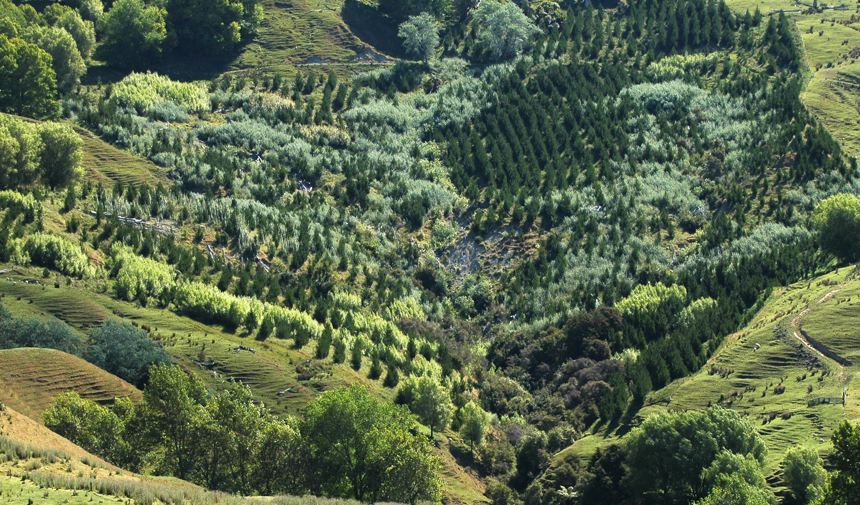
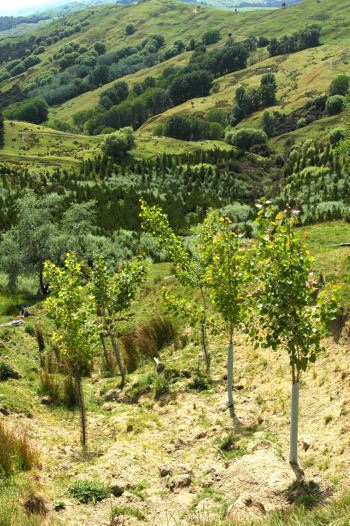
His area of blue moving land is quite small - approximately the size of a house - but bears the brunt of a large catchment of water being channeled into one area. The idea was to slow this water and prevent it from blowing out the blue slip.
First off, pair plantings of silver poplar were made because of resistance to possum damage, and its good strike rate in wet areas. However while silver poplar roots grow quite readily in damp areas, they will not go into water. Consequently the channel between the pair plantings got deeper and deeper, while debris dams in the area had blown out.
The area was fenced off from livestock, the poplars were cut down to see if they would reactivate and an area of about 7 ha was planted in pines around them. Unfortunately it was probably Nick’s worst-ever take in many years of planting pines (he thinks the seedling might have “cooked” in the bags before he got them). On the positive side the silver poplars have taken off again, as have the willows that were also chopped down at the time.
Visually the result is an interesting mix, but Nick is optimistic that there is a growing root mass in the ground and the radiata is coming through, and should take over from the silver poplar in 2-3 more years. He has also planted 3-400 willow wands in the small area that continues to move, and will keep doing that each winter.
Planting Pinus radiata as an erosion control strategy started in 1976, triggered by Nick’s discovery of a crack right through the main stock track on the eastern side of Wensleydale. The combination of a 35 degree slope and a water spring with an increased flow after the storm of 1976 had allowed the soil below to get too heavy and the track was moving. Without that track access to the back of Wensleydale was going to be very difficult to manage.
Silver poplars were already establishing in damp areas close to the creek but the run off had to be slowed and the soils dried out.
Nick decided on a radiata pine conservation planting and with the help of the Government Grant Scheme (GGS) planted 4.9 hectares in 1976. A forest advisory service was a big advantage of the GGS, which gave the owner guidance on growing the trees, silviculture, thinning advice and encouragement - something most pastoral farmers need, says Nick, and a good introduction to forestry for him. The scheme also paid for part of the pruning and thinning.
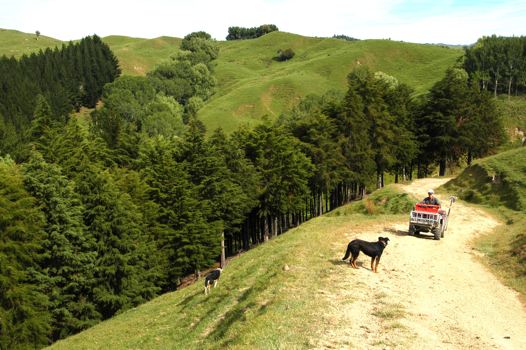
It was vital to save the track, which is used virtually every day, and the trees certainly did that, drying the land out and slowing up the problem spring. They were harvested 31 years later, returning good money for the time but it was the multiple benefits of this planting that were to fundamentally change the way Wensleydale was managed.
Once the trees were established and the first prune completed to two metres, the 5 ha block was integrated back into the sheep husbandry, playing an important role in the farm’s management. Being next to the Waiomoko Road and a paddock that was used after shearing, the gate would be tied open to allow the ewes to seek shelter from the cold southerlies that often, thanks to Murphy’s Law, coincided with shearing each year.
Nick says now that over many years he never lost any sleep or sheep worrying about them being in a safe environment, as they could go in for shelter or out to graze as they pleased.
With Nick, his sheep and the track all stress-free thanks to the pine trees, he’d caught the agroforestry bug and was encouraged to plant another four woodlots of four hectares each, combining livestock management with safe lambing areas, shade and shelter, all on erosion-prone land.
Agroforestry
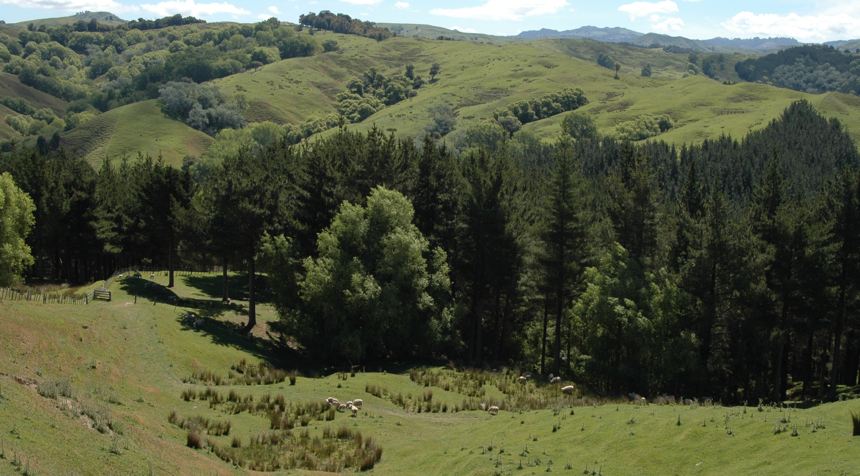
As a diversification strategy to complement sheep, cattle and wool revenue (the fourth leg on the table as Nick describes it) the Seymours agroforestry strategy was carefully thought through and a five year plan prepared.
The strategy has been to plant the lower parts of their paddocks down towards the creeks at 200-300sph then thin to 150. All the blocks were kept at 4-5ha so Nick could prune and thin them himself. He spot sprayed and planted some at 10m spacings (although this sometimes shrank to 8m when he was tired) and helped plant others with contractor Malcolm Galloway.
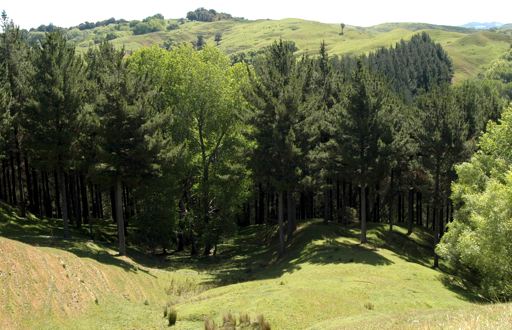 The 80's were pretty tough, very dry years, and like many other sheep farmers the Seymours had little money to spare, so Nick did a lot of pruning of the young trees up to 2 and 4 m. He soon realised the difficulty of sticking to his five year planting plan as well as managing the silviculture, so put planting on hold.
The 80's were pretty tough, very dry years, and like many other sheep farmers the Seymours had little money to spare, so Nick did a lot of pruning of the young trees up to 2 and 4 m. He soon realised the difficulty of sticking to his five year planting plan as well as managing the silviculture, so put planting on hold.
“You’ve got to be flexible,” he says “I could just see the work in front of me... it’s more critical to have the pruning and thinning done on time so we pulled back for a couple of years and then planted the last lot in ’91.
All five agroforestry blocks are now pruned up to 8.5m. Although their DOS (diameter over stump) is quite small he says they are all growing well because they are sheltered in the gullies, get plenty of water and plenty of nutrients off the sheep (so it doesn’t get into the creek). The secret is planning and management he says – ‘RSB’ just doesn’t work. Planning should start a year out before planting, ordering seedlings, organising contractors and fencing.
It is also important to work the trees in with the management of your livestock. At its fundamental level this is simply a case of putting them in the right places and utilising them to best effect. He points to a block where the trees are 18 years old but there’s still grass and they are still putting sheep in there.
He cautions however that planting an agroforestry regime needs careful management to the highest possible standard to achieve good quality timber and maximise revenues.
“We have always pruned hard, we’ve kept the diameter low (about 12cm) and we’ve pruned to 8.5 metres so we’ll get two logs out of them, which will compensate for the waste at the top.”
The East Coast Forestry Project
Planting at Wensleydale dramatically increased in scale with the introduction of the East Coast Forestry Project (ECFP) in the wake of Cyclone Bola in 1988. The East Coast had been racked by a series of droughts through the 80s and Wensleydale was fortunate to be in Bola’s 12-15 inch rain band - just 20 miles away some land was torn to pieces by 36” in 36 hours.
In 92-93 Nick decided to put 140 ha of back country into the ECFP. It was already eroding quite quickly and every storm more soil was being lost, and then to top it off a nasty slip arrived courtesy of Bola.
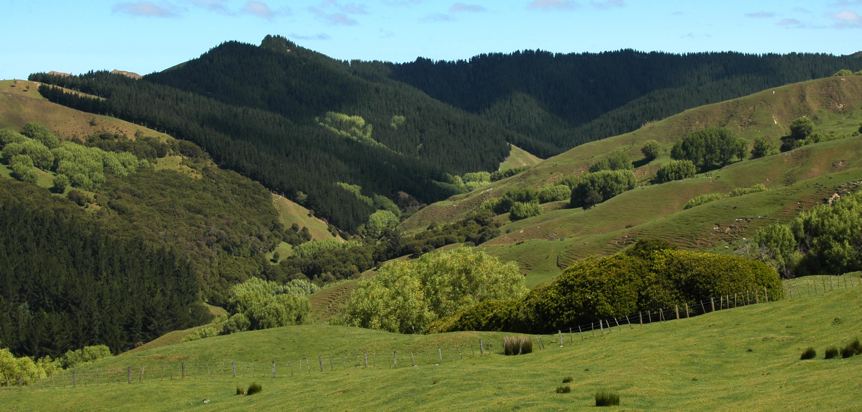
“I had quite a good case. It was at the head of a catchment, it was very steep country, very fast run-off. It used to slip every 10 years or so in a cyclonic event and it was pretty low stocking ‑ about 2 su/ha. We decided to plant it over three years in three blocks. The first block of 30ha went in in 1994 and I got a $1200/ha grant for that. The next year was $1300/ha and that was 80ha and the last one was 30 ha and we got $1400/ha for that.”
ECFP grants were made on a sliding scale with the top rate covering silviculture and thinning. Nick planted for a full pruned regime. As always, he didn’t go into things without planning carefully, already thinking ahead to the day when the trees would come out at harvest.
The Seymours have known all their neighbours for 35-40 years and are on good terms with them – but even so they stress it’s always vital to sort access issues before planting.
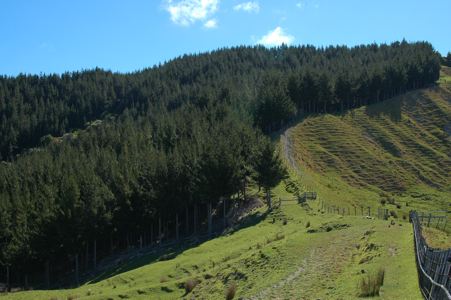
“These things cost you money up front before you’ve even started but they cost you a lot more money if you’ve got 35ha of trees you’re trying to get out and someone’s got you over a barrel,” warns Nick.
The Seymours negotiated with neighbour Patrick Willock who also has blocks of pines that will need to come out one day. They surveyed the road, which Patrick has now built, and at harvest Seymours will pay a royalty (he estimates around $1 a tonne) plus a small lease to cover use of land where the road isn’t formed.
A facilitator was used to ensure both parties achieved what they wanted and Nick sees the resulting agreement as fair, reasonable and cost effective.
At the same time the Seymours established a legal ROW from other neighbours along the top ridge, 20m on their side of the boundary, so they now have access for logging right down to the road which is very important.
Meanwhile the realities of the scale of the project were sinking in. The Seymours felt they needed some form of joint venture or partnership to provide the cash flow needed for 140ha of plantings at an estimated expenditure of $3000/ha. Although they had investors lined up and had identified a workable two-company structure, deep down they weren’t really keen on the idea.
But as Nick says, if you think about a problem long enough something will pop up. His solution? Why not prune half the 140 ha and have a framing regime on the rest?
He calculated that if they were to prune everything, the net return would be very good but they would obviously have to split it 50/50 with the other investors. On the other hand, if they only pruned half and managed the rest in a framing regime at 500 sph the return would be around 90 percent of the pruned regime and would all come to them.
Then it was back to the calculator to work out exactly how to do it. Adding up all the operations that needed to be done - the first prune and second prune on each block plus a third prune and two thins - it didn’t look good. They re-jigged the calculation based on two prunes, one to 4m and one to 6.5m, with one thin on the pruned blocks and just one thin out of the framing regime. The aim was to avoid having to pay for two operations in any one year as this would all be coming out of the farm operation.
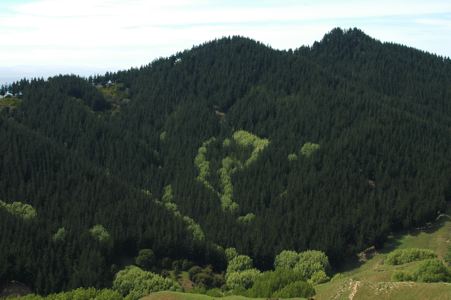
That regime has worked well but even so they needed a sympathetic bank manager when pruning and thinning the 80ha. The work had to be completed, passed and paid for before the claim could go to Wellington, a process that could take up to five months after the operation was done.
Nick followed what was virtually a whole farm plan approach in deciding where to place the different regimes, looking at the various aspects of the land they were planting. Trees on the north and western faces - hot and dry and forming about half of the area - weren’t pruned at all. These have been grown in a framing regime so as not to put them under stress. They have grown slowly and their branches haven’t been as big as the trees on the south and east, which is better country, with a little more topsoil, and formed the pruned area.
These trees were pruned twice up to 6.5m, and had one thin at the end of the year after the final prune, so the sacrifice trees could dominate the forest trees and keep the branches small. Once they had dead branches from about 12.5 – 13 m they were thinned from the initial 1200 to 400 sph, with the sacrifice trees providing nutrients for the next few years.
“We started off in ‘94 with the first cost and the last cost was in 2007,” says Nick. “That’s a few years! But it’s all finished, we’ve got some very good trees out there and they’re all insured.”
Options for the future
After mulling over several different ownership scenarios the Seymours formed Wensleydale Forestry Ltd to carry out the ECFP planting. The land is owned by the estate and the forestry company holds a 90 year forestry right that will cover three rotations. Pat and Nick are the principals and their three children each have a 10 percent share and contribute $25 a week into the forest’s management fund of the forest.
This gives them more of a vested interest in the project than simply looking ahead to eventual inheritance. In addition, should one of the children ever want to come home and farm they could swap shares between the forestry and the farm.
All in all it’s been a good thing to do on that country, says Nick.
“It’s been a complete land use change - you could only ever do it on part of your farm, because you still have to live, and so you still have to have a productive livestock operation.
Silviculture
In addition to the silviculture regime applied to the ECFP plantings, Nick has intensively managed his agroforestry blocks and conducted several trials. In1996 he asked Malcolm Galloway to undertake an audit of the seven stands planted between 1976 and 1992. At that stage the oldest plantation trees, planted in 1976, were 20 years old, and the oldest agroforestry plantings, 1986, were ten years old. Click here to view these stand records.
Harvesting
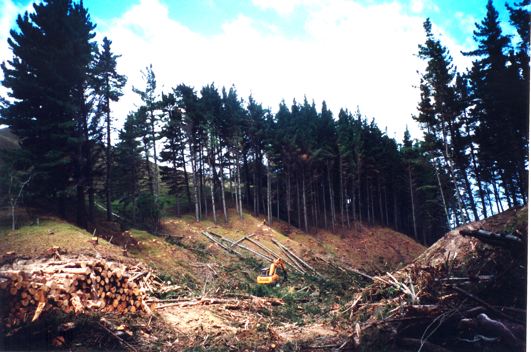
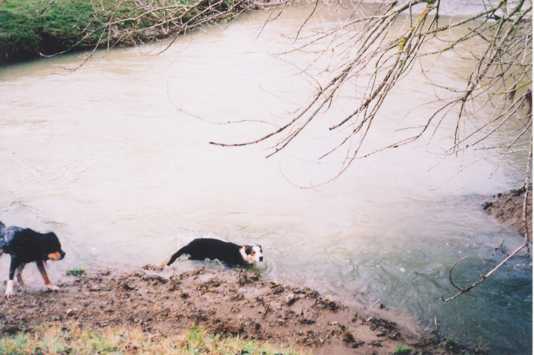
Poplars, macrocarpa and radiata have been harvested through the years for farm timber, but In 2002 the first woodlot trees were 26 years old, and the decision was made to evaluate some of the plots using STANDPAK.
This gave the height of the trees, stocking per hectare and volumes and could be updated at any time with predicted values. PF Olsen Ltd, Gisborne, did this work. The trees became “harvest ready”, a big advantage for any grower with uncommitted forest or lumber as it allows a quick response when markets are favourable.
In 2006 wool, sheep and lamb prices had fallen and with farming costs increasing, it was time to look at this woodlot again. For a management fee of $5.00 per tonne Olsens organised the resource and harvesting consents, a contractor to harvest the block, logging transport, marketing log sales on Nick’s behalf, tracking, skid site tidying up as well as keeping him fully informed throughout the harvesting period.
The now 30year-old trees were tall, over 30 metres high, weighed heavy, and between 60-80 trees were felled each day by a gang of six, including the log maker, with two excavator diggers. A ground hauler with a winch was used to pull over a few outside trees. The 4.9 hectare harvest was completed in 30 days without any rain and only 20 metres of road metal was required on the truck loading area on the skid site.
This was a huge saving in costs as any length of roading and the requirement for rock metal can cut deeply into any profit.
After the dust had settled and the machinery had moved on, it was time to see what dollars would go into the bank account. A very good harvesting report was received and all predictions were exceeded and even bettered when considering the benefits the Seymours’ livestock had received over the previous 30 years.
This started the rotation of harvesting the five 4 hectare woodlots - with one being harvested and replanted every five years, a 30 year growing period will be achieved on a sustainable basis.
Table 1: Returns from forest harvest at Wensleydale, 2007
| Logging costs | 8,444.32 | |
| 2985 tonne | 1465.47 | |
| 667.00 | ||
| 10,576.79 | ||
| Harvest costs | 90,767.70 | |
| (Razorback Logging) | ||
| Management | 14,929.05 | |
| Mapping | 280.00 | |
| Health and Safety | 550.00 | |
| Skid construction | 2,548.00 | |
| Tracking | 3,480.00 | |
| 149.02 | ||
| Transport | 28,729.05 | |
| $152,009.61 | ||
| Log Sales | 277,685.55 | |
| 7,457.13 | ||
| 285,142.68 | ||
| Costs | 152,009.61 | |
| Nett GST | $133,133.07 |
| Total log sales | 285,142.68 |
| Total costs | 152,009.61 |
| Nett less GST | 133,133.07 |
| Harvest area | |
| Return/ha | $27,170.00 |
| ÷ 30 years = return p.a. | $905.65 |
| Costs % | 53.30 |
| Return % | 46.70 |
Log Harvest
2985 tonne ÷ 4.9 ha 609.18 tonne/ha
Management
2985 tonne @ $5.00 14,929.05
Harvest costs
2985 @ $30.40 907.67
Compare this with a livestock gross p/a of $525 annum p/ha average for the last six years.
Nick says being harvest ready is the key - five years before you need to go - so you can monitor what your trees are doing, whether they’re still growing or not, and find a harvesting contractor. There will always be people out there but the availability of good crews is often limited.
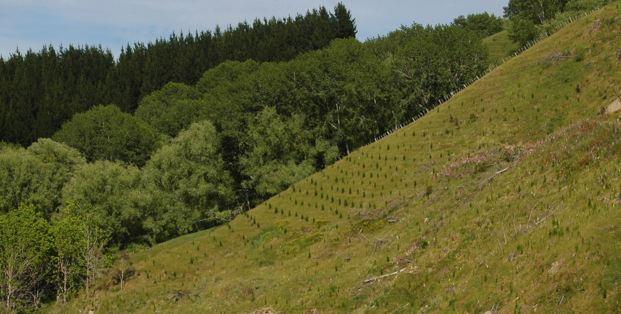
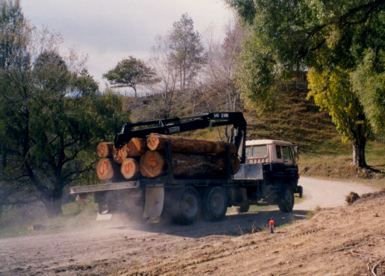
Fodder
Willows have been topped in drought for cattle food. They leave a bit of a mess, says Nick, but it all breaks down after a couple of years.
“It was really good for the cows - they hear the chainsaw and they come running, so much so that sometimes they’re under the tree when you’re chopping it down! But it’s very good for them, quite good to do it in the autumn, then you can save a bit of feed up for the winter.”
It’s also quite good for the trees he adds, because most of the Catchment Board plantings never had a tree management plan as such. Some of them get quite big, and the big matsudana willows will end up with 3-4 big branches. When these get too big they will split or the tree itself will split from the sheer weight on the stem.
Nick warns that cutting willows is a dangerous job and says it’s not something to encourage people to do until they have developed skills and have all the right gear, including safety helmet, chaps and boots. He even built himself a special stool that he could lean up against the tree and stand on.
“It meant I wasn’t standing on a limb… I was on a low angle but it got me up the tree about 2-3 feet. It was light enough - built of poplar so I could carry it around in one hand with a chainsaw in the other. I could just hop up and start limbing, - it was pretty good because you’ve got to get out of the way fast with willows. You need a fast cutting chainsaw because when they hit the ground they just come back, they spring, so it’s a pretty dangerous job. I think I broke one stool and the second one I manage to fix up a couple of times.”
Restoration of native bush
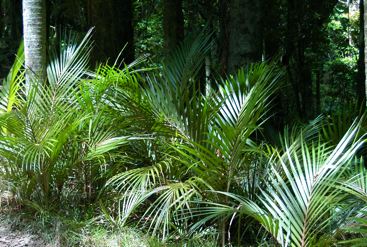
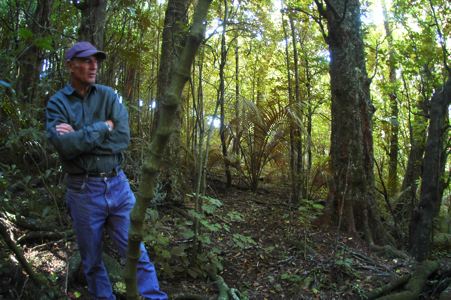
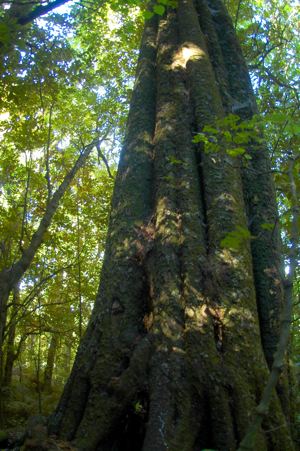
Before settlement all the eastern and southern country in the district had big bush on it… podocarps, puriri, rewa rewa, tawa and kohekohe, totara, matais and a few pukateas. Remnants remain in the 30 ha of native bush now under QEII covenant and are a good indication that this diversity can be retained and enhanced once predator control and protection from stock is put in place.
The pioneer species in the two smaller bush reserves are kawakawa and nikau and a luxuriant understorey is coming away now that stock are excluded. Native passionfruit, white maire and ferns are also returning.
“It’s pretty easy, you just fence it off and do the possum and vermin control for stoats and wild cats,” Nick says. He might sound casual, but it’s obvious they are both pleased and proud of the results. And for those considering a similar move, Nick says dealing with the QEII Trust was a good experience and painless, particularly because they had done already done much of the physical work, and only the formalities of covenanting remained.
Other species
There’s more to forestry at Wensleydale than radiata and erosion control - the property has been planted with a diversity of species which, while not necessarily in great numbers, have been selected with an eye for both beauty and high value timber production.
Nick is particularly interested in the potential of Australian hardwoods for timber. He says Acacia falciformis, the hickory wattle, is looking promising, as is the cedar wattle, A. elata. He believes they will grow well on a warm fertile site and would be appropriate for applications such as furniture.
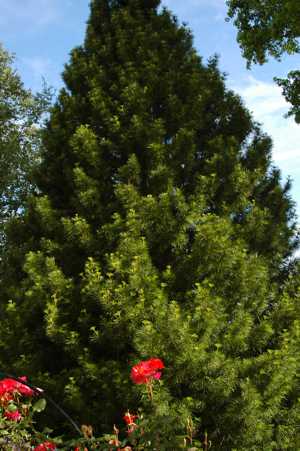
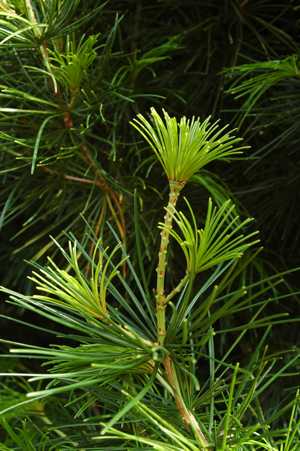
Other species on the property include Cupressus lusitanica, Cedrus deodora, black walnut, Douglas fir, A. dealbata and A. melanoxylon.
He has also planted a few redwoods around one of the covenanted native bush blocks. “They’re an ideal tree for around native bush because the native seedlings will grow under them which is useful for long term growth planning. In the valley we’ve got oaks and alders and gingkos and plane trees and all sorts of things just to break it up.”
Amenity planting
While Nick has tended his trees, Pat Seymour has created an outstanding 1.5 ha garden, where magnificent rose bushes are set off against a background of trees, and exotic specimens such as the Japanese umbrella pine (Sciadopytis verticillata) fascinate tree lovers. Plantings of oaks, gingkos and liquidambars are just some of the amenity species that have been planted around the property, which is ablaze with colour in autumn.
